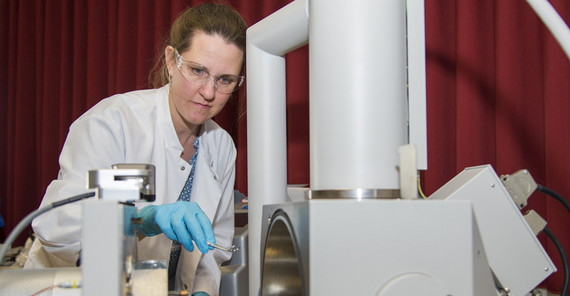She is active, goal-oriented, welcomes new challenges, and enjoys teaching and research. Food chemist Dr. Claudia Pacholski has been teaching and doing research at the University of Potsdam since 2014. Funding from a Heisenberg Fellowship of the German Research Community (DFG) – which she raised herself – has enabled her to initiate new research projects and to extend existing ones.
Claudia Pacholski's CV is quite exceptional. Before she came to Potsdam, she had already left her scientific marks in various fields at several universities and research institutes. This was not always easy for her because she and her partner, also a chemist, had to “cope with things separately”. After her studies in Hamburg, Pacholski did not change the university but her research focus for the first time.
“I was very interested in food chemistry but it was too much analysis for my liking. I quickly realized that I wanted to work more broadly.” Even in her first state exam, she was already working on organic synthesis. She looked at impurities in the production of pharmaceuticals and wrote her dissertation on the synthesis and characterization of semiconductor nanoparticles. Pacholski successfully applied for several scholarships. For two years, she was a postdoc at the University of California, San Diego, USA and later, she worked at the Max Planck Institutes for Metal Research and Intelligent Systems, where she focused on developing structured surfaces for biosensor applications.
Tiny biosensors as the future of measurement technology
Pacholski has been working at the University of Potsdam since 2014, initially as a principle investigator of a project funded by the Volkswagen Foundation. Since 2016, she has been a Heisenberg Fellow and heads the research group “Functional Nanostructures”. The research team synthesizes nanomaterials – i.e. chemical substances or materials whose particle range in size from 1-100 nanometers – and is interested in both chemical and optical properties. “We are focusing on the preparation and self-assembly of inorganic materials in combination with polymers to produce materials with new, extraordinary properties.” Pacholski and her group specifically investigate how to use the material they developed as biosensors – sensors with biological components. They are based on the coupling of a biologically active system, for example, antibodies or enzymes, with a signal transducer and an electronic amplifier and are used in biotechnological measurement technology.
Pacholski's projects defy neat categorization. The interdisciplinary approach of combining physical inorganic chemicals, colloids, and biosensors is very important but is not always easy to do. “A successful application must convince all expert reviewers, and this can be difficult when there are many disciplines involved,” the researcher explains. That she was able to raise third-party funds proves her right.
She is currently working on chemically producing periodic metal hole arrays in gold film. “As opposed to conventional methods used for the generation of such hole structure –s, for example electron-beam lithography and ion-beam etching, this method is fast, cost-effective, and can be done in any chemistry laboratory.” These hole arrays have already been successfully tested as sensors.
Nanomaterials with novel properties
Another research project deals with photonic nanomaterials, which include metamaterials, artificially produced structures, and so-called photonic crystals. They can have optical properties, which were only recently discovered, for example negative refractive indices. The Potsdam group is focusing on the production and characterization of photonic nanomaterials through self-assembly: small building blocks, which form well-ordered structures. The “Lego principle” allows large quantities of innovative material to be quickly and cost-effectively produced, resulting in tailor-made materials for specific applications.
Porous silicon is also of scientific interest to Pacholski. It is a form of the chemical element silicon with a specific structure. Porous silicon is suitable for producing solar cells and rechargeable batteries due to their special optical and electrical properties. An expert selection of various manufacturing parameters – such as the type of silicon or the concentration of fluoride ions – results in porous nanoscale and microstructures that are particularly interesting for optical applications such as filters or sensors.
It is helpful for Pacholski that she does not have to buy expensive equipment and materials for these projects. The researcher is strongly supported by the research group of Prof. Hans-Gerd Löhmannsröben and the innoFSPEC research network team. In addition to good research opportunities, contact with students and doctoral students is very important to her. This exchange, the search for answers to unusual questions, and exploring the unknown all inspire and motivate her.
The Project
Bottom-up fabrication of tailor-made plasmonic sensors for the specific and sensitive detection of target analytes in complex matrices
Duration: 2016–2019
Partner institutions: University of Stuttgart, Karlsruhe Institute of Technology (KIT), University of Konstanz, Friedrich Schiller University Jena, Universidad Autonoma del Estado de Morelos, Mexico
The Researcher
Dr. Claudia Pacholski studied food chemistry at the University of Hamburg. Since 2016, she has worked as Heisenberg Fellow at the Institute of Chemistry of the University of Potsdam.
Universität Potsdam
Institut für Chemie
Am Mühlenberg 3
14476 Potsdam
E-Mail: cpacholsuuni-potsdampde
BU Seite 85 Dr. Claudia Pacholski in the lab
Text: Dr. Barbara Eckardt
Translation: Susanne Voigt
Published online by: Marieke Bäumer
Contact for the online editorial office: onlineredaktionuuni-potsdampde
Read this and other articles on research at the University of Potsdam in our research magazine Portal Wissen.

